Pepperoni and sausage pizza is a delicious choice, but have you ever wondered how many calories it contains? Understanding the calorie content of this popular pizza can help you make informed choices about your food. It’s no secret that pizza can be high in calories and fat, so let’s dive into the numbers.
- Pepperoni and sausage pizza can vary in calorie content depending on factors like brand and preparation method.
- On average, a slice of pepperoni and sausage pizza (1/8 of a 12″ diameter) contains around 280 calories.
- Approximately 37% of the calories in a slice come from fat, 47% from carbohydrates, and 16% from protein.
- Portion control and mindful eating are important when enjoying pizza as part of a balanced diet.
- Making healthier pizza choices, such as opting for thin crust and adding plenty of veggies, can help reduce calorie intake.
By arming yourself with knowledge about the calorie content of pepperoni and sausage pizza, you can make more informed decisions about portion sizes and overall dietary intake. Remember, balance is key when enjoying your favorite indulgences!
Uncovering the Nutritional Information
Let’s take a closer look at the nutritional breakdown of pepperoni and sausage pizza. Understanding the calorie count and other nutritional information can help us make informed choices about our food.
According to one source, a slice of pepperoni and sausage pizza (1/8 of a 12″ diameter) contains approximately 280 calories. Out of these calories, 37% come from fat, 47% from carbohydrates, and 16% from protein. Another source provides similar information, stating that a single slice of pepperoni and sausage pizza (1/8 of a 12″ diameter) contains 280 calories, 11.54g of fat, 32.39g of carbohydrates, and 10.92g of protein.
For a small-sized pepperoni and sausage pizza (20 cm diameter), the nutritional values vary slightly. It is estimated to have about 995 calories, with 41.04g of fat, 115.16g of carbohydrates, and 38.84g of protein. However, it’s important to note that these values may vary depending on the brand and preparation method.
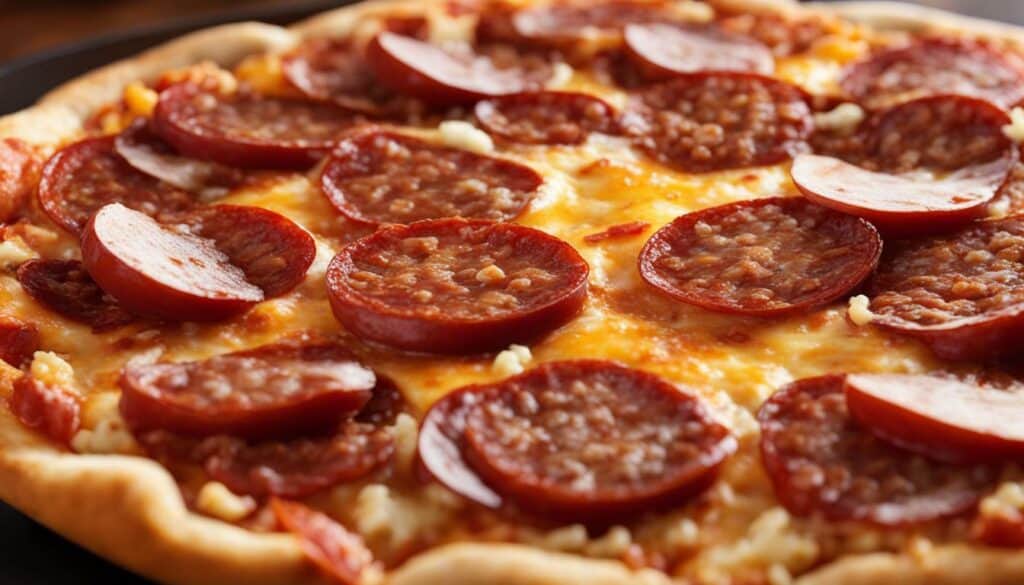
By being aware of the calorie content and nutritional breakdown of pepperoni and sausage pizza, we can make more conscious choices about our portion sizes and overall dietary intake. It’s crucial to keep in mind that moderation plays a key role in maintaining a balanced diet while still enjoying indulgent foods like pizza. Customization also offers an opportunity to make healthier choices by opting for thin crust, adding more vegetables, and choosing leaner meat toppings.
| Calories | Fat (g) | Carbohydrates (g) | Protein (g) | |
|---|---|---|---|---|
| 1 slice (1/8 of a 12″ diameter) | Approx. 280 | 11.54 | 32.39 | 10.92 |
| 1 small pizza (20 cm diameter) | Approx. 995 | 41.04 | 115.16 | 38.84 |
Understanding the nutritional information of pepperoni and sausage pizza is just one piece of the puzzle when it comes to maintaining a healthy eating plan. By considering the overall nutritional value of our meals and snacks throughout the day, we can ensure we are making well-rounded choices that fit into our dietary goals.
Calories in a Slice
Wondering how many calories are packed into a single slice of pepperoni and sausage pizza? Read on to find out. When it comes to indulging in a delicious slice of pizza, it’s important to be aware of the nutritional information and calorie count. Pepperoni and sausage pizza can be a tempting choice, but it’s essential to understand the potential impact it can have on your dietary intake.
According to various sources, a typical slice of pepperoni and sausage pizza (1/8 of a 12″ diameter) contains approximately 280 calories. These values may vary based on different factors such as the brand and preparation method used. It’s worth noting that around 37% of the calories in a slice of pepperoni and sausage pizza come from fat, 47% from carbohydrates, and 16% from protein. This breakdown highlights the importance of considering the overall balance of macronutrients in your diet.
To give you a better understanding, let’s take a closer look at the nutritional values of a slice of pepperoni and sausage pizza. One source states that a single slice contains 11.54g of fat, 32.39g of carbohydrates, and 10.92g of protein. These numbers provide valuable insight into the composition of the pizza and help guide your portion sizes and dietary choices.
| Nutrient | Amount per Slice |
|---|---|
| Calories | 280 |
| Fat | 11.54g |
| Carbohydrates | 32.39g |
| Protein | 10.92g |
Keep in mind that these numbers represent the average values for a slice of pepperoni and sausage pizza, and actual values may vary. It’s always a good idea to check the specific nutritional information provided by the brand or establishment you’re getting your pizza from. By staying informed about the calorie content of your chosen slice, you can make mindful decisions and strike a balance between enjoying your favorite pizza and maintaining a healthy diet.
Understanding the calorie content of pepperoni and sausage pizza can help you make informed decisions about portion sizes and your overall dietary intake. While it’s no secret that pizza can be high in calories and fat, knowing the specific nutritional values can guide you in finding a balance between indulgence and healthy eating. Let’s take a closer look at the calorie count and other aspects of this beloved pizza.
According to one source, a piece of pepperoni and sausage pizza (1/8 of a 12″ diameter) contains around 280 calories, with 37% of the calories coming from fat, 47% from carbohydrates, and 16% from protein. Another source provides similar information, stating that 1 piece of pepperoni and sausage pizza (1/8 of a 12″ diameter) contains 280 calories, 11.54g of fat, 32.39g of carbohydrates, and 10.92g of protein.
These numbers may vary based on the brand and preparation method used. For instance, a third source lists the nutritional values for a small pepperoni and sausage pizza (20 cm diameter) as approximately 995 calories, with 41.04g of fat, 115.16g of carbohydrates, and 38.84g of protein. It’s essential to consider these values when determining portion sizes and managing your daily calorie intake.
By understanding the calorie content of pepperoni and sausage pizza, you can make more mindful choices. Remember, a balanced diet is key to maintaining overall health and well-being. Pizza can still be enjoyed as part of a healthy eating plan by opting for smaller portions, loading up on vegetable toppings, and considering thin crust options. Customizing your pizza to fit your dietary needs can help you strike a balance between indulgence and maintaining a balanced diet.
Variations in Caloric Content
It’s important to note that the calorie content of pepperoni and sausage pizza can vary depending on factors such as the brand and how it’s prepared. Different brands may have different recipes and nutritional information, leading to variations in calorie counts. Additionally, the method of preparation can also impact the overall calorie content. For example, pizzas that are deep-fried or loaded with extra cheese and oils will likely have higher calorie counts than those that are baked or made with lighter toppings.
To give you a better understanding of these variations, here is a comparison table showcasing the calorie content of popular brands and preparation methods:
As you can see from the table, there can be significant differences in the calorie content of pepperoni and sausage pizza depending on the brand or preparation method. Therefore, it’s always a good idea to check the nutritional information and serving sizes provided on the packaging or consult a reliable calorie calculator to get an accurate estimation of the calories in your slice of pizza.
Understanding these variations can help you make more informed choices when it comes to your pizza consumption. By being aware of the potential differences in calorie content, you can adjust your portion sizes and toppings accordingly to align with your dietary goals and preferences.

Enjoying pepperoni and sausage pizza while maintaining a healthy eating plan is possible with a few smart choices. By making slight modifications to your pizza toppings and crust options, you can satisfy your cravings while still staying on track with your dietary goals.
To create a diet-friendly pizza, start with a thin crust. Thin crust pizzas generally have fewer calories and less fat compared to their thicker counterparts. This allows you to enjoy the flavors of the pepperoni and sausage without adding unnecessary calories. Additionally, opting for a whole wheat or gluten-free crust can provide added nutritional benefits.
When it comes to choosing pizza toppings, consider using leaner options. Instead of traditional pepperoni and sausage, try using turkey pepperoni or chicken sausage for a lower fat content. You can also load up on vegetables like bell peppers, onions, and mushrooms to add flavor and nutrients without adding excessive calories.
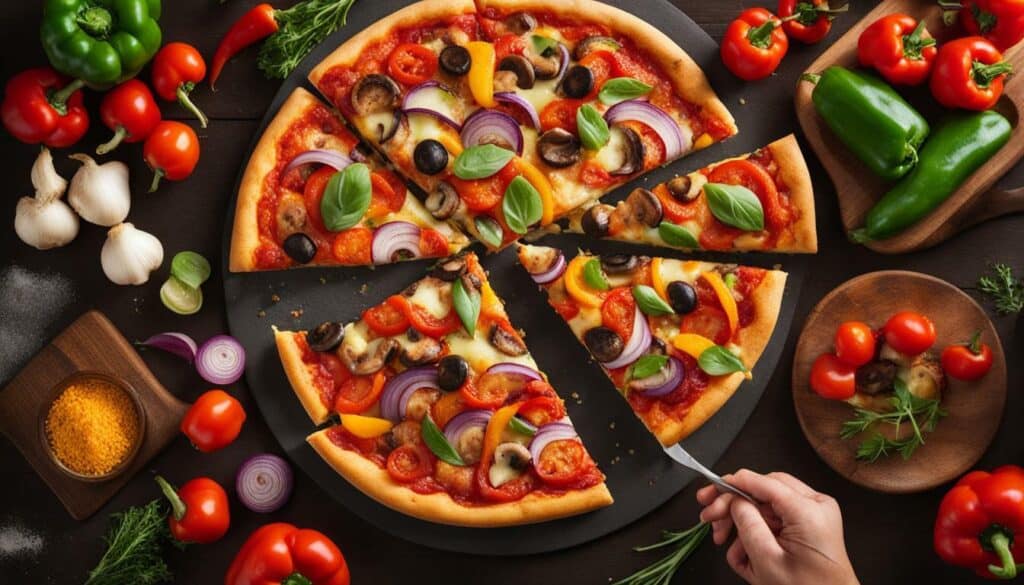
Customization is key when it comes to making healthier pizza choices. Don’t be afraid to ask for modifications when ordering from a restaurant or experiment with different ingredients when making pizza at home. This way, you can tailor your pizza to meet your individual dietary needs and preferences.
Remember, pizza can still be part of a balanced and healthy eating plan. By being mindful of your pizza choices and incorporating other nutritious meals and snacks throughout the day, you can enjoy the occasional indulgence without compromising your overall health goals.
| Pepperoni and Sausage Pizza Nutritional Information: | Calories | Fat (g) | Carbohydrates (g) | Protein (g) |
|---|---|---|---|---|
| 1/8 of a 12″ diameter pizza (source 1) | 280 | 10.39 | 32.39 | 10.92 |
| 1/8 of a 12″ diameter pizza (source 2) | 280 | 11.54 | 32.39 | 10.92 |
| Small (20 cm diameter) pizza (source 3) | 995 | 41.04 | 115.16 | 38.84 |
Tips for Making Healthier Pizza Choices
Want to enjoy a guilt-free slice of pepperoni and sausage pizza? Try these tips for making healthier choices. By making a few simple modifications, you can still indulge in your favorite flavors while prioritizing your health and well-being.
1. Opt for Thin Crust
Skip the thick, doughy crust and go for a thin crust instead. Thin crust pizza typically has fewer calories and less carbohydrate content compared to its thicker counterparts. Not only will this help cut down on calories, but it also allows the toppings to shine.
2. Load Up on Veggies
Add an abundance of colorful vegetables to your pizza to amp up the nutritional value. Bell peppers, mushrooms, spinach, and onions are all excellent choices that provide essential vitamins and minerals. Plus, they add flavor and texture without significantly increasing the calorie count.
3. Choose Lean Meat Toppings
When it comes to meat toppings, opt for leaner alternatives. Swap out the fatty pepperoni and sausage for grilled chicken, turkey, or lean ham. These options still provide protein but with less saturated fat. You can also experiment with plant-based protein alternatives like tofu or tempeh for a vegetarian or vegan pizza.
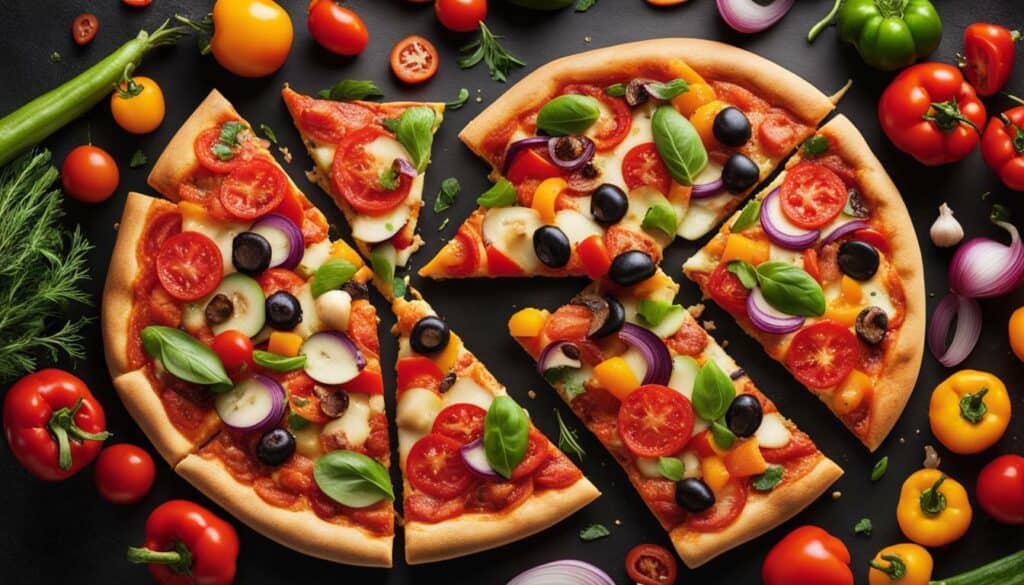
4. Control Your Portion Sizes
Portion control is key when enjoying pizza. Instead of devouring an entire pizza, savor a smaller portion and pair it with a fresh side salad or vegetable soup. This will help you feel satisfied while incorporating additional nutrients into your meal.
| Topping | Calories per slice | Fat (g) | Carbohydrates (g) | Protein (g) |
|---|---|---|---|---|
| Pepperoni and Sausage | 280 | 11.54 | 32.39 | 10.92 |
| Grilled Chicken | 240 | 6.78 | 27.61 | 13.79 |
| Vegetarian (Assorted Veggies) | 220 | 7.93 | 28.46 | 8.87 |
Remember, balance is key. While it’s alright to enjoy the occasional slice of pepperoni and sausage pizza, making healthier choices most of the time can contribute to an overall nutritious diet. So go ahead and savor that slice knowing you’ve made a more mindful choice.
Understanding the Big Picture
Remember, the calorie content of pepperoni and sausage pizza is just one piece of the puzzle when it comes to maintaining a healthy eating plan. While it’s important to be aware of the calorie count in your favorite pizza, it’s equally important to consider the nutritional value of other meals and snacks throughout the day. A balanced diet consists of a variety of nutrient-dense foods that provide essential vitamins, minerals, and macronutrients.
When enjoying a slice of pepperoni and sausage pizza, it’s helpful to keep portion sizes in mind. Opting for a smaller slice or sharing a pizza with a friend can help manage calorie intake. Additionally, consider customizing your pizza toppings to maximize nutritional benefits. Adding vegetables like bell peppers, mushrooms, and spinach not only adds flavor and texture but also boosts the overall nutritional value of the pizza.
By making conscious choices when it comes to pizza, such as opting for a thinner crust, choosing leaner meat toppings, and incorporating plenty of vegetables, you can strike a balance between indulgence and healthy eating. Remember, moderation is key. Enjoying a slice of pepperoni and sausage pizza occasionally as part of a well-rounded diet can still be a part of a healthy lifestyle.
| Calories | Fat | Carbohydrates | Protein |
|---|---|---|---|
| 280 | 11.54g | 32.39g | 10.92g |
Understanding the calorie content of pepperoni and sausage pizza empowers you to make mindful choices that align with your health goals. By considering portion sizes, balancing toppings, and incorporating a variety of nutritious foods into your diet, you can enjoy pizza in a way that supports your overall well-being.
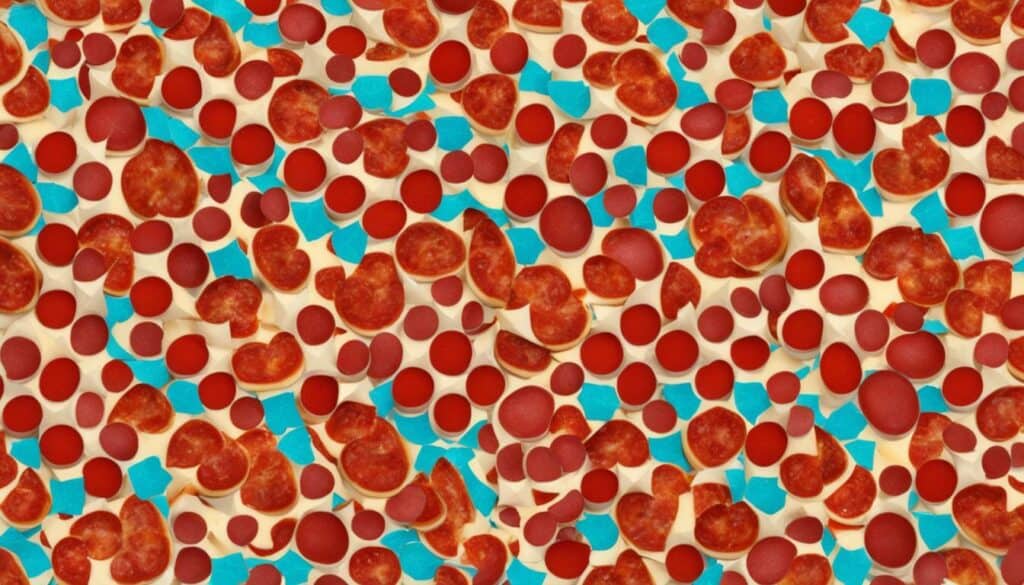
- Maintaining a healthy eating plan goes beyond just considering the calorie content of pepperoni and sausage pizza.
- Balance your overall diet by incorporating nutrient-dense foods throughout the day.
- Opt for smaller portions and customize your pizza toppings to maximize nutritional benefits.
- Enjoying pizza occasionally as part of a well-rounded diet is possible with moderation and mindful choices.
Remember, making informed decisions about your food choices is key to maintaining a healthy lifestyle.
Conclusion
Understanding the calories in pepperoni and sausage pizza empowers you to make mindful choices, striking a balance between indulgence and maintaining a healthy eating plan. Pepperoni and sausage pizza is undeniably delicious, but it’s important to be aware of its nutritional content, especially if you’re watching your calorie intake.
Based on various sources, a typical slice of pepperoni and sausage pizza (1/8 of a 12″ diameter) contains around 280 calories, with the majority of the calories coming from fat and carbohydrates. These values may vary depending on the brand and preparation method, but it serves as a general guideline.
By being conscious of the calorie content, you can determine appropriate portion sizes and make necessary adjustments to your overall dietary intake. It’s all about finding a balance that works for you – indulging in a slice or two once in a while while still prioritizing a healthy eating plan.
Furthermore, remember that not all pizzas are created equal. Opting for healthier choices like thin crust, leaner meat toppings, and adding plenty of veggies can help reduce the calorie content while still enjoying the flavors you love. Customization is key in creating a pizza that aligns with your dietary needs and goals.
Don’t let the calorie content of pepperoni and sausage pizza deter you from savoring this classic dish. With knowledge and moderation, you can still enjoy pizza while maintaining a healthy lifestyle. So go ahead, savor a slice or two, and make mindful choices that support your overall well-being.
FAQ
Q: What is the calorie content of pepperoni and sausage pizza?
A: The calorie content of pepperoni and sausage pizza can vary depending on the size and brand. However, on average, a piece of pepperoni and sausage pizza (1/8 of a 12″ diameter) contains around 280 calories.
Q: What percentage of the calories come from fat, carbohydrates, and protein in pepperoni and sausage pizza?
A: Approximately 37% of the calories in pepperoni and sausage pizza come from fat, 47% from carbohydrates, and 16% from protein.
Q: How much fat, carbohydrates, and protein does a piece of pepperoni and sausage pizza contain?
A: On average, a piece of pepperoni and sausage pizza (1/8 of a 12″ diameter) contains approximately 11.54g of fat, 32.39g of carbohydrates, and 10.92g of protein.
Q: Are there any variations in the calorie content of pepperoni and sausage pizza?
A: Yes, the calorie content can vary based on factors such as the brand and preparation method. It’s important to check the nutritional information provided by the specific brand or restaurant.
Q: How should I incorporate pepperoni and sausage pizza into a balanced diet?
A: While pepperoni and sausage pizza can be indulgent, it’s important to enjoy it in moderation and consider portion sizes. Balance your meal by adding plenty of vegetables and opting for a healthier crust option, such as thin crust.
Q: Can I make healthier choices when it comes to pizza toppings?
A: Absolutely! To make healthier pizza choices, consider using leaner meat toppings, such as turkey pepperoni, and load up on veggies for added nutrition. Customizing your toppings can help create a healthier and more balanced pizza.
Q: How does understanding the calorie content of pepperoni and sausage pizza fit into overall healthy eating?
A: Understanding the calorie content of pepperoni and sausage pizza is just one aspect of maintaining a balanced and healthy diet. It’s important to consider the nutritional value of other meals and snacks throughout the day to ensure overall healthy eating habits.
Are Mozzarella Sticks Healthier Than Pepperoni and Sausage Pizza?
When comparing the calories in 5 mozzarella sticks to a slice of pepperoni and sausage pizza, the former is generally a better choice for those watching their calorie intake. Mozzarella sticks tend to have fewer calories than the greasy pizza options, making them a relatively healthier option for snack time or light meals.

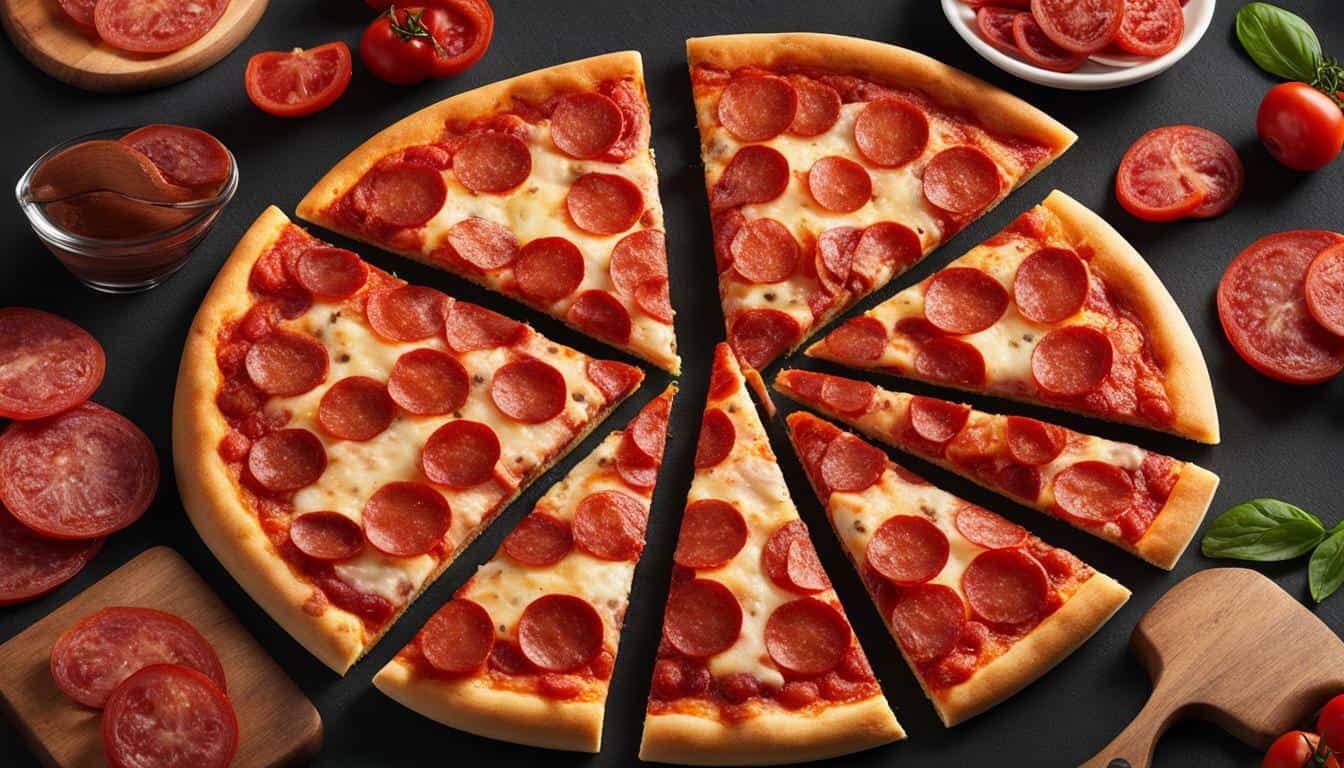



Leave a Reply